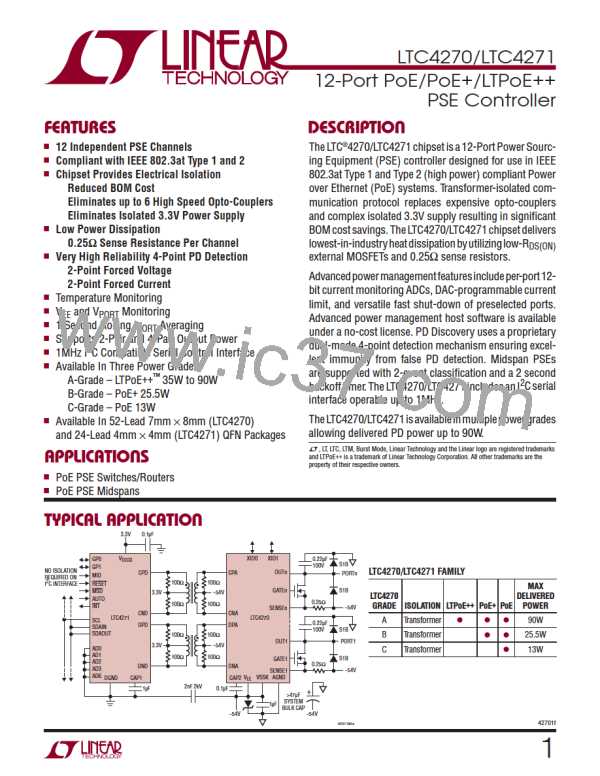LTC4270/LTC4271
APPLICATIONS INFORMATION
OVERVIEW
++
to 90W of delivered power to a LTPoE PD. The LTPoE
++
specification provides reliable detection and classification
extensions to the existing IEEE PoE protocols that are
backwardcompatibleandinteroperablewithexistingType
Power over Ethernet, or PoE, is a standard protocol for
sending DC power over copper Ethernet data wiring. The
IEEE group that administers the 802.3 Ethernet data stan-
dardsaddedPoEpoweringcapabilityin2003.Thisoriginal
PoE spec, known as 802.3af, allowed for 48V DC power at
upto13W. Thisinitialspecificationwaswidelypopular, but
13W was not adequate for some requirements. In 2009,
the IEEE released a new standard, known as 802.3at or
++
1andType2PDs.UnlikeotherproprietaryPoE solutions
++
Linear’s LTPoE provides mutual identification between
++
the PSE and PD. This ensures the LTPoE PD knows it
may use the requested power at start-up because it has
++
++
detected a LTPoE PSE. LTPoE PSEs can differentiate
++
between a LTPoE PD and all other types of IEEE compli-
+
PoE , increasing the voltage and current requirements to
++
ant PDs allowing LTPoE PSEs to remain compliant and
provide 25W of power.
interoperable with existing equipment.
The IEEE standard also defines PoE terminology. A device
that provides power to the network is known as a PSE, or
powersourcingequipment,whileadevicethatdrawspower
from the network is known as a PD, or powered device.
PSEs come in two types: Endpoints (typically network
switches or routers), which provide data and power; and
Midspans, which provide power but pass through data.
MidspansaretypicallyusedtoaddPoEcapabilitytoexisting
non-PoE networks. PDs are typically IP phones, wireless
access points, security cameras, and similar devices.
LTC4270/LTC4271 Product Family
The LTC4270/LTC4271 family is a fourth generation
12-port PSE controller that implements 12 PSE ports in
either an endpoint or midspan design. Virtually all neces-
sary circuitry is included to implement an IEEE 802.3at
compliant PSE design, requiring only an external power
MOSFET and sense resistor per channel; these minimize
power loss compared to alternative designs with onboard
MOSFETs and increase system reliability in the event a
single channel fails.
++
PoE Evolution
All grades of the LTC4270/LTC4271 family offer advanced
fourth generation PSE features, including per-port current
+
Even during the process of creating the IEEE PoE 25.5W
specification it became clear that there was a significant
and increasing need for more than 25.5W of delivered
power. The A-grade LTC4270/LTC4271 chipset responds
to this market by allowing a reliable means of providing up
monitoring, global temperature and V monitoring, port
EE
current policing, one second current averaging and four
general purpose input/output pins.
CAT 5
20Ω MAX
ROUNDTRIP
0.05μF MAX
PSE
PD
RJ45
4
RJ45
4
5
5
GND
1N4002
SPARE PAIR
w4
0.22μF
100V
X7R
1
1
DGND
AGND
5μF ≤ C
IN
≤ 300μF
SMAJ58A
58V
Tx
Rx
Tx
3.3V
V
DD33
INT
1/12
LTC4270/
LTC4271
2
3
2
3
INTERRUPT
DATA PAIR
DATA PAIR
SMAJ58A
SCL
SDAIN
SDAOUT
2
I C
0.1μF
1N4002
w4
Rx
V
EE
SENSE GATE OUT
1μF
GND
6
6
100V
X7R
DC/DC
CONVERTER
R
PWRGD
+
OUT
CLASS
S1B
V
0.25Ω
LTC4265
–48V
7
8
7
–48V
–48V
OUT
–
IN
8
S1B
SPARE PAIR
42701 F10
Figure 10. Power over Ethernet System Diagram
42701f
16

 Linear [ Linear ]
Linear [ Linear ]